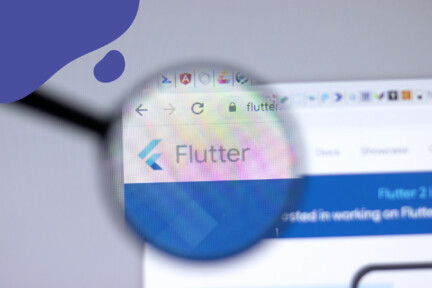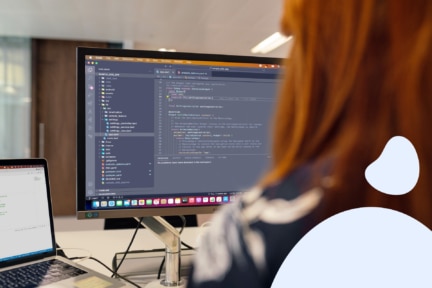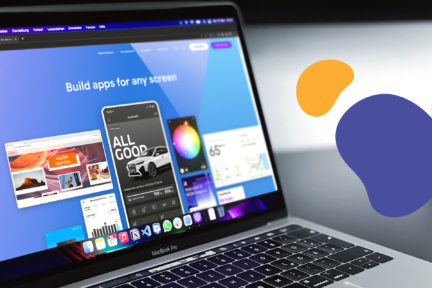Flutter is a powerful cross-platform, open-source framework created by Google in 2017. Despite its youth, it’s already shaking up the mobile app development scene. While it gained popularity over the years as an excellent tool for proofs of concept and MVPs, it’s now significantly impacting enterprise app development.
Why choose Flutter for enterprise app development? Let’s break it down. In this article, we’ll explore its strengths, discuss potential obstacles, and highlight its adaptability across various situations. Then, we’ll dive deep into Flutter’s perks, challenges, and practical applications for enterprise businesses. And that’s not all – we’ll also get a sneak peek into Flutter’s future trajectory, its rising adoption across industries, and how it stacks up against other well-known cross-platform frameworks.
Popular cross-platform frameworks vs Flutter for enterprise app development
When considering cross-platform frameworks like React Native and Xamarin in comparison to Flutter for enterprise app development, it’s important to note their distinctive features. Flutter, powered by the Dart programming language, excels by enabling developers to create natively compiled applications for multiple platforms from a unified codebase. Its hot reload functionality accelerates the development process by instantly reflecting code changes. Moreover, Flutter development for enterprise apps boasts an extensive assortment of customizable widgets, enhancing UI flexibility.
In contrast, React Native relies on JavaScript and offers a native look and feel across both iOS and Android platforms. With a robust developer community and the capability to integrate native code seamlessly, it remains a favored choice for enterprise apps. Meanwhile, Xamarin utilizes C# and the .NET framework to deliver interfaces that mimic native design conventions, fostering a coherent integration into the Microsoft ecosystem.
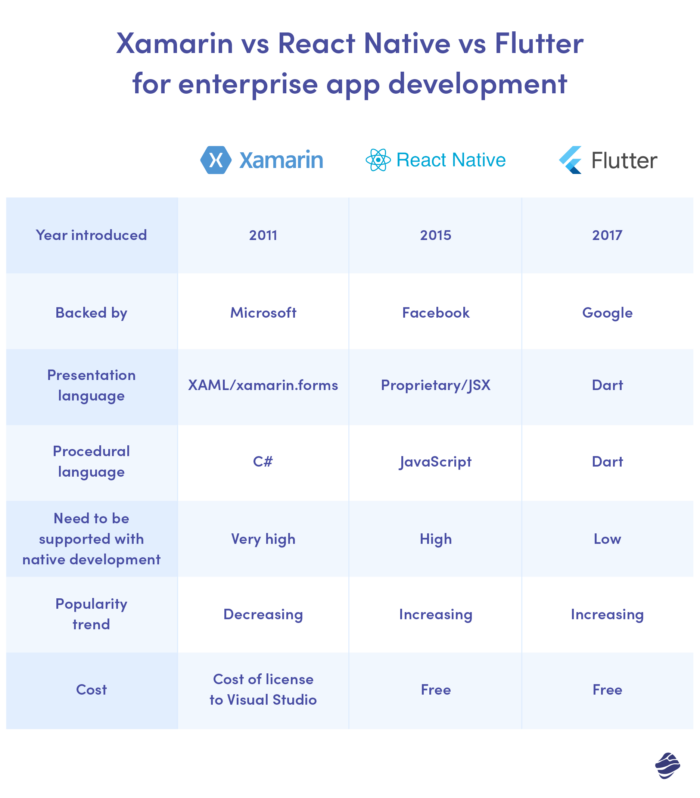
In terms of enterprise-level considerations, Flutter distinguishes itself with its comprehensive set of tools and performance optimization strategies. This can lead to streamlined development and enhanced user experiences. React Native’s popularity within the developer community ensures a wealth of resources and support, while Xamarin’s strong affiliation with Microsoft can be advantageous for businesses entrenched in that ecosystem.
Ultimately, choosing the ideal framework hinges on factors such as project requirements, existing technological investments, and the desired balance between rapid development and native performance for enterprise app development. If you want to learn more about cross-platform app development, take a look at our comparisons of Flutter vs React Native or Flutter vs Xamarin – and get to know solutions that best suit your needs.
Benefits of Flutter for enterprise apps
Implementing Flutter for enterprise apps presents several advantages encompassing web and mobile application development. First and foremost, Flutter for enterprise apps offers the edge of a unified codebase for iOS and Android, ensuring consistent user experiences across platforms. Its Hot Reload feature accelerates development cycles while customizable UI widgets, native-like performance, and an extensive ecosystem further enhance app quality and capabilities.
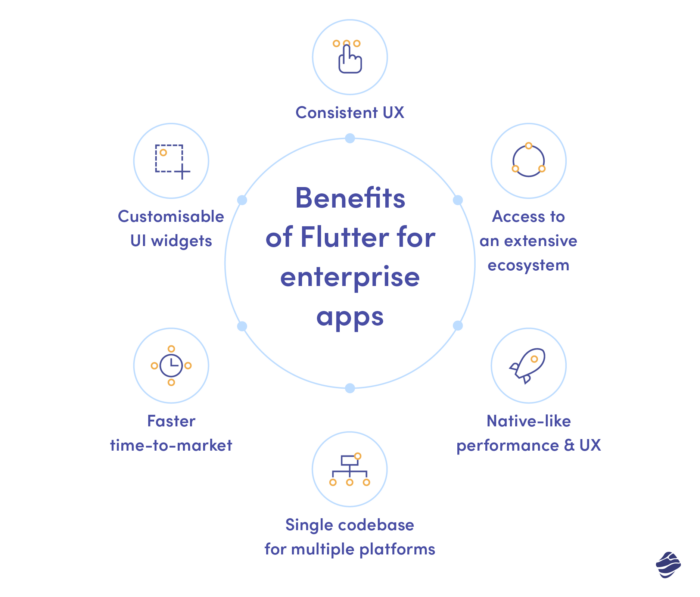
Breaking it down, the most significant benefits of Flutter for enterprise app development are:
- Single Codebase for iOS and Android: With Flutter, businesses can save valuable time and resources by writing a single codebase that can be used to develop apps for both iOS and Android platforms. No more duplication of efforts or maintaining separate codebases!
- Consistent User Experience Across Platforms: Flutter for enterprise apps allows businesses to deliver a consistent user experience across multiple platforms. By utilizing this framework, enterprises can ensure that their app’s look, feel, and behavior remain consistent across different devices, providing a seamless experience for users regardless of the platform they are using.
- Faster Time-to-Market: Flutter’s remarkable feature called “hot reload” empowers developers to see instant changes in the app during the development process. This means faster iterations, quicker refinements, and accelerated development cycles. With Flutter, large businesses can swiftly gather feedback, and deliver updates to their users in a timely manner.
- Beautiful and Customizable UI Widgets: Flutter for enterprise app development boasts an impressive collection of customizable UI widgets, allowing businesses to create stunning and visually appealing interfaces that align perfectly with their brand. Tailor-made designs that engage and captivate users are now within reach for businesses of all shapes and sizes.
- Native-like Performance and User Experience: Flutter’s underlying architecture and rendering engine enable apps to deliver a seamless, high-performance experience comparable to native apps. Users won’t notice any difference in performance or responsiveness.
- Access to an Extensive Ecosystem: Flutter benefits from a thriving community that has contributed a vast array of packages and plugins. This opens up a world of possibilities for integrating services, APIs, and libraries, enabling businesses to extend their app’s capabilities effortlessly.
Challenges in Flutter for enterprise app development
While Flutter brings numerous advantages, it’s important to be aware of potential challenges in the development journey. One of the primary hurdles is integrating Flutter into an existing technological ecosystem, as enterprises typically rely on diverse and complex infrastructures. Ensuring seamless interoperability with legacy systems, databases, and third-party APIs requires meticulous planning and efficient integration strategies. Additionally, enterprise apps often demand a high level of customization and scalability to cater to diverse user needs, leading to challenges in managing state, performance optimization, and maintaining a consistent user experience across various platforms and devices.
Addressing these challenges demands a comprehensive understanding of both Flutter’s capabilities and the specific requirements of enterprise-grade applications, coupled with strategic architectural decisions and a well-coordinated development approach.
The other challenges associated with choosing Flutter for enterprise app development are:
- Learning Curve: For developers who are new to Dart (the programming language used in Flutter) and the framework itself, there might be a slight learning curve. However, with Flutter’s user-friendly syntax and comprehensive documentation, the learning process can be exciting and rewarding.
- Delayed access to the latest platform-specific features: Flutter is designed to provide cross-platform compatibility, which means that certain newest features introduced in one platform may be delivered with a delay. This means that businesses relying on the latest features provided by specific platforms should turn to native solutions.
- Third-Party Integration and Support: While Flutter has a growing ecosystem of packages and plugins, there might still be instances where specific integrations or support for certain third-party services or libraries is limited compared to more established frameworks. It’s important to assess the availability and compatibility of the required integrations before committing to Flutter for your project.
- Flutter’s Maturity in Enterprise Environments: While Flutter has gained traction in the mobile app development space, its maturity in enterprise environments may still be a consideration for some businesses. Enterprises often have unique requirements, such as stringent security protocols, compliance standards, and integration with existing systems. Evaluating whether Flutter can meet these specific enterprise needs is crucial to ensure a successful implementation.
- Long-term maintenance: Flutter, along with the Dart language, is constantly evolving, and frequent framework updates are being delivered. This means that developers should stay up to date with the latest developments and be aware of future features to ensure a smooth app development journey.
Applications of Flutter for enterprise app development
Flutter applications span a multitude of business sectors and address various needs. Internally, the platform excels in enhancing productivity through its capacity to craft visually appealing and user-friendly interfaces, which proves invaluable for developing internal productivity tools. Task management, employee collaboration, and workflow optimization apps thrive under Flutter’s cross-platform mobile app development capabilities, streamlining operations and efficiency.
In the realm of customer-facing applications, Flutter for enterprise apps truly shines in sectors like e-commerce and retail. By harnessing its rich UI toolkit, businesses can create compelling and high-performing apps that captivate users. The technology drives customer engagement, bolsters conversion rates, and offers a seamlessly immersive shopping experience, characterized by fluid animations, captivating visuals, and user-friendly interfaces.
Flutter for enterprise apps equals greater adaptability
Flutter’s adaptability extends to the optimization of business processes. Enterprises can leverage its capabilities to automate intricate procedures, be it inventory management, supply chain optimization, or document processing. The platform’s flexibility empowers the creation of applications that are efficient and effective, thereby streamlining the fundamental operations that drive organizations.
Real-time collaboration and communication find a potent ally in Flutter. Businesses can leverage its strengths to develop applications that facilitate seamless team collaboration, video conferencing, messaging, and file sharing. The technology fosters efficient teamwork and bolsters communication among team members, regardless of their physical locations.
Across various industries such as travel, hospitality, and healthcare, Flutter emerges as a robust solution for developing commercial applications. These apps serve as powerful tools for delivering exceptional user experiences, showcasing services, and engaging customers. With feature-rich functionalities and captivating visual elements, these commercial Flutter apps play a pivotal role in leaving a lasting impression on the users they serve.
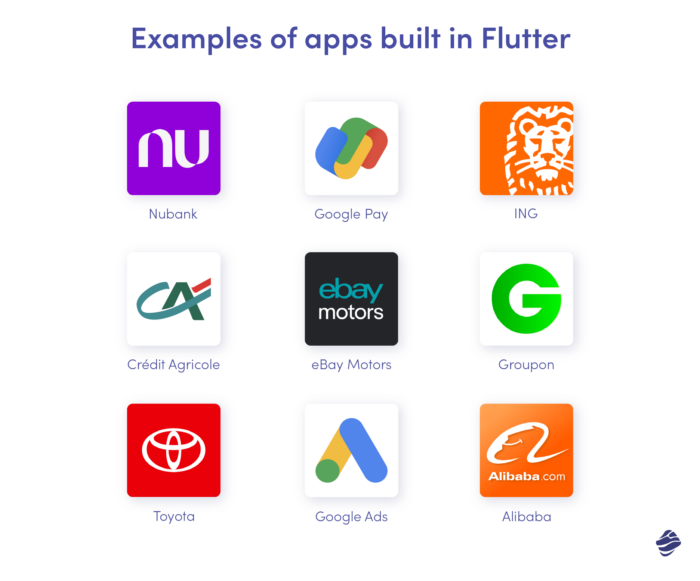
Examples of Flutter in enterprise app landscape
Flutter for enterprise apps has demonstrated its prowess through numerous examples. One such instance is reflected in the banking and fintech sector, where top-tier financial institutions like Nextbank, GooglePay and NuBank have utilized Flutter’s cross-platform capabilities to develop unified mobile apps that provide customers with consistent and seamless experiences across different devices.
In eCommerce and customer engagement apps like PAJO, Flutter’s rich UI toolkit empowers businesses to forge captivating shopping experiences with seamless navigation, interactive product catalogs, and efficient checkout processes, while its cross-platform nature ensures consistent performance across devices. In the music sector, Flutter enables the creation of immersive and visually striking music streaming platforms, characterized by smooth animations, personalized playlists, and real-time updates, elevating user engagement and satisfaction.
Let’s explore the examples of prominent enterprise apps where Flutter’s versatility fosters innovation, enabling businesses to create applications that redefine customer interaction, satisfaction, and operational efficiency.
1. Banking Flutter app for Nextbank
Nextbank is a software-as-a-service company that provides cloud banking services to 30 banks in Southeast Asia. They offer a bank-in-a-box solution with 10 web and mobile white-label products for custom retail and corporate banking applications. These products allow financial institutions to develop customized retail and corporate banking applications within a remarkably short timeframe of less than 10 weeks. Miquido played a vital role in developing Nextbank’s flagship mobile banking application, which brought about a significant transformation in the finance industry of the Philippines in just five years.
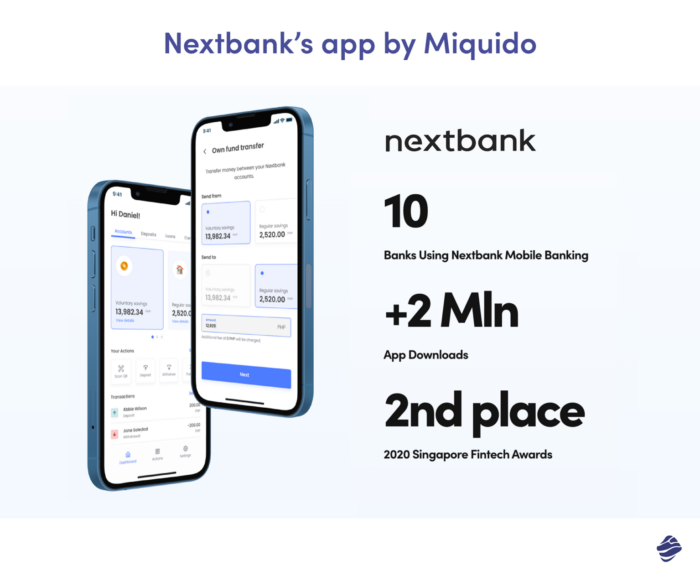
Challenges included seamless third-party integrations, compliance with OWASP security standards, and designing a universal white-label app. Solutions involved using native code for data handling, conducting pen-testing and external audits, and creating a cohesive design system to ensure smooth user experience. The functionalities of the mobile app included user onboarding, secure registration, biometric authentication, account management, money transfers, bill payments, and more.
Results included confirmed security through IT audits, native-like performance, cost-effective design and maintenance, and continuous development of innovative features. Flutter’s flexibility enabled Nextbank to continuously evolve its offerings in line with market trends and customer expectations. They introduced innovative features like QR code payments and InstaPay, which allows for quick transfer of electronic funds. Miquido’s support in building an in-house development team further solidified Nextbank’s position as a mature and dynamic project. They continue to receive ongoing technological and consulting support from Miquido.
Key points:
- Nextbank is a software-as-a-service company providing cloud banking services to 30 banks in Southeast Asia.
- Sensitive data handling followed OWASP security standards, utilizing native code for secure storage.
- The collaboration resulted in robust and validated security measures and a native-like performance.
- A cohesive design system facilitated a personalized and visually appealing user experience.
- The partnership between Nextbank and Miquido revolutionized the banking sector in Southeast Asia.
Tech stack:
- Flutter
- Bloc State Management Library
- Firebase (Analytics, Crashlytics, Messaging)
- Meta App Events
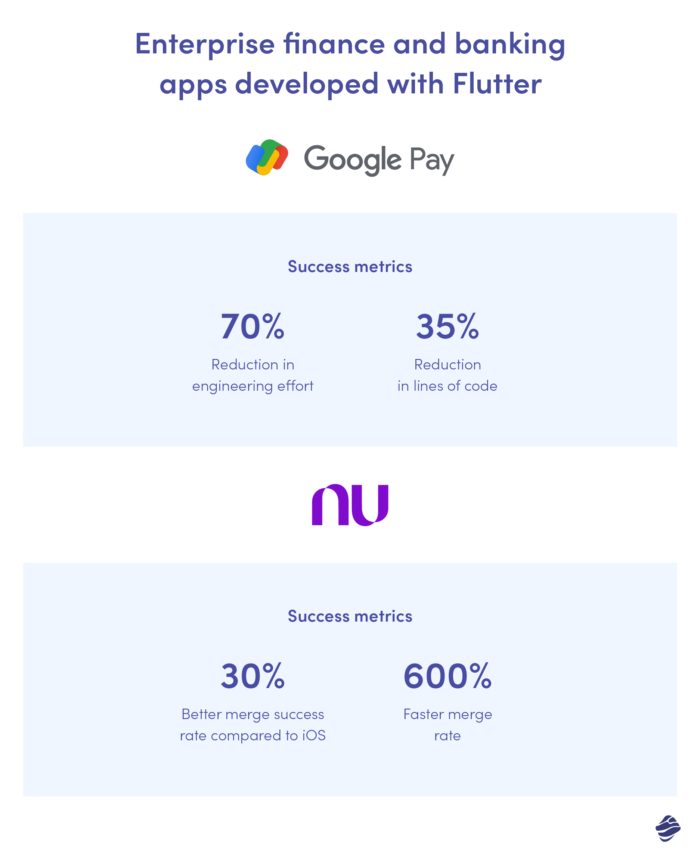
2. Google Pay: A million-users app created with Flutter
Google Pay, with 100 million users worldwide, faced the challenge of supporting a large number of iOS users in new regions while predominantly serving Android users. They needed a sustainable solution as they expanded to new countries with unique features. To address this, they decided to invest in Flutter, a cross-platform framework, which would enable them to unify their engineering efforts and increase development speed and efficiency. Migrating to Flutter would allow them to scale Google Pay globally in a fast and resource-efficient manner.
Rebuilding Google Pay on Flutter required retraining the team and rewriting the app, while also undergoing security reviews and audits. They formed a small team to build a vertical slice of the app using Flutter and received positive feedback from other engineers during small sprints. With approval from senior management, they brought in 50 engineers and spent six months retraining and rewriting the app for a beta launch in Singapore.
The beta testing was successful, and the rebuilt app is smaller, easier to manage, and more efficient, with 35% less code. Despite adding several new features, the new codebase is 1.1 million lines of code instead of the original 1.7 million. The team estimates saving 60-70% of their engineers’ time due to Flutter’s ease of management.
Key points:
- Google Pay opted to invest in Flutter, a cross-platform framework, to unify their engineering efforts and increase development speed and efficiency.
- Migrating to Flutter allowed for fast and resource-efficient scaling of Google Pay worldwide.
- The launch of the beta version was successful, with the rebuilt app being smaller, easier to manage, and more efficient, with 35% less code.
- The team estimates saving 60-70% of their engineers’ time due to Flutter’s ease of management.
3. Flutter Music App: Topline by Abbey Road Studios
The Miquido team successfully created both the native iOS app and its Flutter version within a tight timeframe of just 10 weeks. They overcame audio latency issues on Android, resulting in a high-quality user experience. The app’s success was recognized as it was featured at prestigious events like Google I/O and Flutter Live in 2018. Additionally, Google showcased Topline in their Flutter Developer Stories series, and it received two awards at the UK App Awards 2018.
The services provided by Miquido included user research, UI/UX design, and mobile development, with the tech stack consisting of Swift for the native iOS app and Flutter for the cross-platform version. The Miquido team demonstrated their expertise and dedication to delivering a top-notch product.
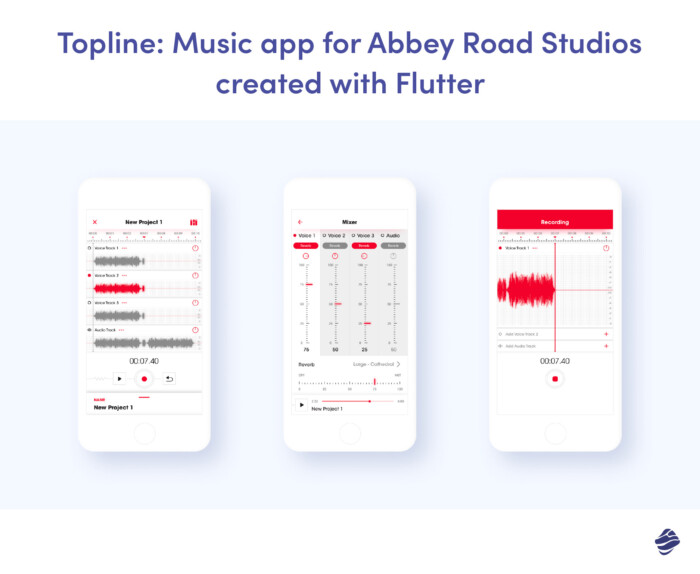
The partnership between Miquido and Abbey Road Studios was characterized by excellent collaboration and customer focus. Miquido went the extra mile to negotiate costs and deliver within a flexible scope, ensuring the best interests of Abbey Road Studios were prioritized. The Senior Digital Marketing Manager of Abbey Road Studios praised Miquido’s commitment to quality and their seamless integration into the digital space.
Overall, Topline serves as a prime example of Miquido’s ability to create award-winning Flutter mobile apps that garner recognition from industry giants like Google. The success of Topline showcases the Miquido team’s technical prowess, attention to detail, and dedication to delivering outstanding results for their clients.
Key points:
- Topline is a music recording app solution developed by the Miquido team.
- The app allows artists to instantly save their music ideas by recording tracks, adding lyrics, sharing files, and easily sync them to the cloud.
- The Miquido team created both a native iOS app and a Flutter version of Topline.
- Topline was featured at Google I/O in May 2018 and Flutter Live 2018.
- It was showcased by Google in Flutter Developer Stories and won two categories at the UK App Awards 2018.
- The Miquido team provided services such as user research, UI/UX design, and mobile development.
- The Miquido team was praised for their ease of collaboration, negotiation skills, and customer focus
Tech stack:
- Flutter
- Swift
4. Wolt: A leading merchant app rewritten with Flutter
Wolt’s journey of migrating their merchant app to Flutter showcases the flexibility, speed, and quality that Flutter offers. As a company with multiple product teams serving customers, couriers, and merchants, Wolt recognized the need to provide robust applications for all parties involved. They decided to scale up their existing Picker app, built with Flutter, to become the future merchant app for Wolt.
The decision to choose Flutter was based on its stability, flexibility, and the growing community behind it. Despite initial skepticism and the need to build knowledge in Flutter, the engineering teams at Wolt quickly embraced the technology and saw the benefits it offered. They were able to create a responsive UI that works seamlessly across different screen sizes, ensuring a high-quality user experience.
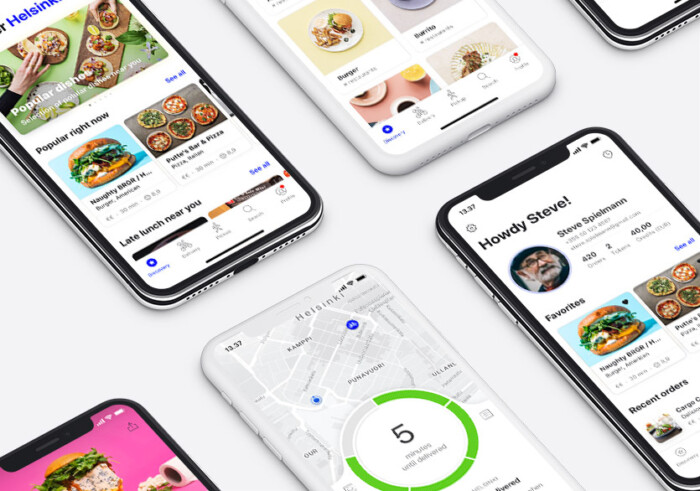
The migration process did come with challenges, including adapting the backend tech stack and ensuring quality as the app scaled rapidly. However, Wolt invested in robust systems, test coverage, and backend scalability to handle the increased usage. Collaboration, flexibility, and speed were key factors in successfully migrating to Flutter.
The results have been promising, with the new Flutter-based merchant app proving to be efficient, user-friendly, and visually appealing. Wolt continues to migrate more users to the new app, confident in the decision they made and the benefits Flutter brings to their business. This journey serves as a testament to the power of Flutter in enabling companies to make significant changes while maintaining high standards of quality and user experience.
Key points:
- Flutter was chosen for its stability, flexibility, and cross-platform capabilities.
- Wolt prioritized efficiency, speed, and collaboration in making their decision and executing the migration.
- They focused on quality, scalability, and robust systems to handle the rapid growth of their app.
- Wolt continues to migrate more users to the new app, confident in their choice of Flutter.
- Flutter enables companies to make significant changes while upholding quality and meeting evolving user needs.
5. PAJO: A marketing tools suite and customer engagement app made with Flutter Web
PAJO, a marketing tools suite, partnered with Miquido to create a web application that provides a mobile-like experience using Flutter for Web development. Despite the early stage of Flutter Web, both teams recognized the potential and worked together to integrate the best omnichannel practices. The collaboration began in 2020 and involved overcoming limitations and occasional bugs in the Flutter Web engine.
Miquido’s Flutter Tech Lead provided full-time support to ensure the successful delivery of the proof of concept. The team creatively addressed challenges such as search engine optimization, scrolling performance, and initial loading time. They modified requirements and found workarounds to create a web application that closely emulates the native mobile experience.
The development process was divided into two phases:
- In the first phase, the team delivered the minimum viable product within five weeks, implementing features like user sign-up, onboarding, integration with QR code systems, and personalized UI themes.
- The second phase focused on scaling the web application and enhancing the user experience with secure, password-less registration via email.
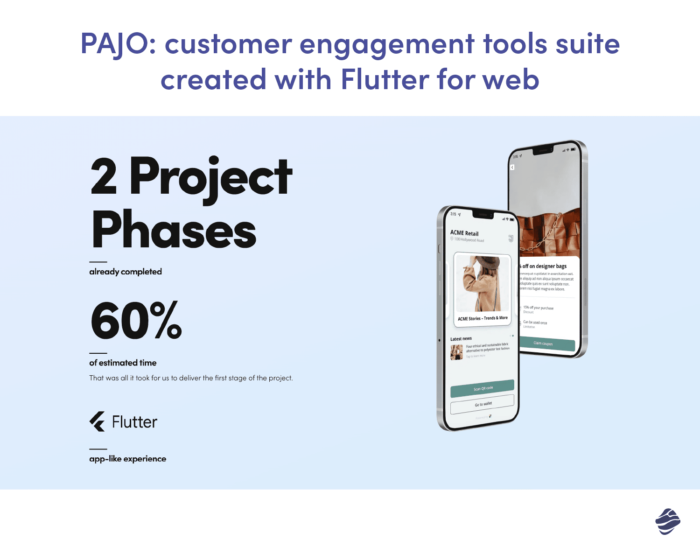
The collaboration resulted in an engaging website for PAJO, featuring gamification elements and secure user registration. The Flutter-based web solution provided an efficient product that mirrored the mobile application experience. The successful delivery of the proof of concept allowed PAJO to explore markets quickly and test the product effectively.
The partnership with Miquido exceeded expectations, with the initial project assumptions completed 40% faster than anticipated. This allowed for budget allocation to enrich the content library with new Moments and a comprehensive Wallet for coupon codes. The implementation of quick user registration and onboarding further enhanced the user experience.
Overall, the collaboration between PAJO and Miquido showcased the potential of Flutter Web in creating a web application with a mobile-like experience. The teams demonstrated creativity, problem-solving skills, and the ability to deliver a fully functional proof of concept.
Key points:
- PAJO is a marketing tools suite that utilizes QR codes to connect with users in physical locations.
- PAJO achieved seamless customer onboarding and gamification elements.
- The Miquido team leveraged Flutter Web to create a web application with a mobile-like experience.
- The development process was split into two phases, resulting in a fully functional proof of concept.
- The project was delivered 40% faster than expected, allowing for further content library diversification.
Tech stack:
- Web application development: Flutter Web
- Analytics: Firebase Analytics & Segment
- Passwordless Firebase Authentication
- Crash reporting: Sentry SDK
- CI on Github
- CD with Firebase Hosting
6. Scaling customer-centric product development at BMW with Flutter
The mobile app team at BMW Group faced the challenge of maintaining feature and design consistency between their iOS and Android vehicle companion apps. They needed a solution that would allow simultaneous releases across brands, platforms, and regions without increasing costs. Flutter was evaluated alongside other cross-platform frameworks and proved to be the most promising option.
Less than a year later, the My BMW App was launched in July 2020, providing a seamless experience for users across 47 countries. The development team established the “Mobile 2.0 Platform,” enabling automated builds, tests, and deployments for every brand, market, and operating system. This streamlined process resulted in faster development and eliminated feature disparities between platforms.
The switch to Flutter brought consistency to the user experience and improved feedback, particularly for Android users. With Flutter, the team could move faster, maintain app consistency, and ultimately delight users.
Key points:
- BMW Group faced the challenge of maintaining feature consistency between their iOS and Android vehicle companion apps.
- Flutter was chosen as the cross-platform solution to rewrite all app variants across brands, platforms, and regions with a single codebase.
- The My BMW App was launched in July 2020, providing a seamless experience for users in 47 countries.
- Switching to Flutter eliminated feature disparities and improved user feedback, especially for Android users.
7. Timesheets: Time-tracking app made with Flutter
Timesheets is an intuitive AI-powered time-tracking solution designed for co-operating, multitasking teams. It simplifies the process of tracking working hours and monitoring time spent on each project or task, providing accurate time reports. With the inclusion of a Custom Business Intelligence dashboard, Timesheets offers invoicing support and helps identify any irregularities in the reports, ensuring that no working hours go unnoticed.
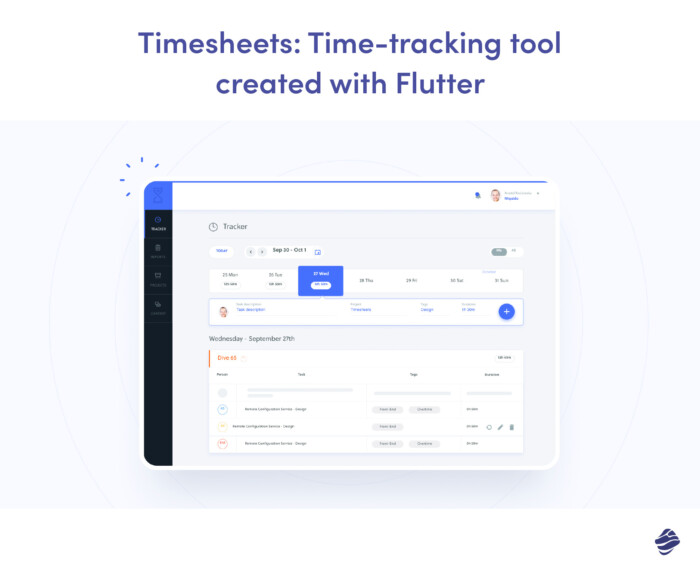
Originally developed to address the needs of Miquido, the solution proved to be valuable for other businesses struggling to find an effective time-tracking tool, leading to its release for wider use. Timesheets seamlessly integrates with popular tools such as voice assistants (Google Assistant, Alexa, Siri), chatbots (Slack, Hangouts), and plugins (Jira), enhancing its functionality. Leveraging Google Dialogflow, the design and setup of the Natural Language Understanding engine in Timesheets enable intuitive interactions.
Miquido offers services in web development, mobile development, design, and artificial intelligence to support the implementation and customization of Timesheets.
Key points:
- Timesheets is an AI-powered time-tracking tool designed for multitasking teams.
- Timesheets tracks working hours and time spent on projects or tasks, allowing for accurate time reports.
- Timesheets integrates with popular tools such as voice assistants (Google Assistant, Alexa, Siri), chatbots (Slack, Hangouts), and plugins (Jira).
- The solution utilizes Google Dialogflow for the design and setup of its Natural Language Understanding engine.
Tech stack:
- Flutter
- AWS Glue
- AWS SageMaker
- Apache Spark
- PostgreSQL
- Google Data Studio
8. eBay: Leading multinational eCommerce platform enhanced with Flutter
The eBay Motors team was tasked with developing a new app for auto enthusiasts on both Android and iOS platforms within a year. Due to limited resources, they sought a cross-platform solution and decided to give Flutter a try. After testing Flutter’s capabilities and attending workshops to learn the framework, the team found the development experience to be fun, fast, and enjoyable. Flutter allowed for extensive code sharing, covering UI, business logic, domain models, analytics, network stack, and more.
The biggest challenge was unifying the Android and iOS teams, but with careful planning, they successfully formed a single, stronger team. By using Flutter, the eBay Motors team dramatically reduced development time and met all production deadlines.
The new eBay Motors app received positive feedback from users and developers, with 100% of developers preferring Flutter over iOS or Android development. Flutter’s speed and efficiency allowed for weekly releases and simultaneous feature additions on both platforms. The team now shares 98.3% of their code, resulting in streamlined processes and increased productivity. The team’s increased speed and robust test automation led to converting QA engineers into software engineers. Overall, Flutter fundamentally changed the team’s workflow, making them happier, more productive, and more excited about their work.
Key points:
- Flutter provided a fast, enjoyable, and efficient development experience for the team.
- Out-of-the-box robust testing support in Flutter exceeded eBay’s expectations.
- By using Flutter, the team reduced development time and met all production deadlines.
- Flutter’s speed and efficiency allowed for weekly releases and simultaneous feature additions on both platforms.
- Code sharing reached 98.3%, resulting in streamlined processes and increased productivity.
- Flutter for enterprise app development fundamentally changed the team’s workflow, making them happier, more productive, and more excited about their work.
Future Outlook and Adoption Trends of Flutter
In 2022, Flutter became the most popular cross-platform framework and is the most loved among all Google’s developer products. With its remarkable growth and widespread adoption, Flutter has cemented its position as the go-to choice for developers seeking efficiency and excellence. So will Flutter rest on its laurels or will it introduce even more changes? According to Flutter 2023 Strategy document, Flutter Team’s goal remains the same for several years:
“Our mission is to build the most popular, highest-quality, and highest-productivity UI toolkit for developers”
What lies behind this mission? Let’s find out how the Flutter team intends to achieve their goal.
Their core planning principles focus on prioritizing the developer experience, building trust and reputation and supporting the growth of a diverse community. Flutter’s 2023 investments concentrate on six sub-areas of developer experience, which are believed to be crucial for active user growth.
- Performance: Improving performance across platforms, optimizing compilation, enhancing the edit/compile/debug cycle, and providing better tooling for issue diagnosis.
- Interoperability: Making it easier to integrate Flutter with existing apps and platforms, including reducing costs for calling native libraries and improving interop with Android, iOS, web, Windows, and macOS.
- Portability: Ensuring Flutter and Dart support a broad range of platforms, including WebAssembly (Wasm), ARM-based desktop operating systems, and potential future use on RISC-V.
- Ecosystem: Building a cohesive full-stack experience by investing in vertical toolkits for specific domains, partnering with other tooling providers, and collaborating with the broader ecosystem.
- Security: Enhancing the security of Flutter through code signing, reproducible builds, tooling support for building secure applications, and clarifying data collection and analytics practices.
- Fundamentals: Taking care of the basics such as documentation, engineering velocity, addressing technical debt, UI fidelity, and customer issue resolution.
To learn more about early progress against each of the mentioned areas, check Flutter Forward 2023: What do the innovations announced by Google mean for your business?
What the future holds for Flutter for enterprise app development
Undoubtedly, Flutter is poised for a promising future. With its versatility, focus on app quality, and strategically crafted roadmap for developer support, Flutter is set to make a significant impact on cross-platform app development in years to come. By prioritizing performance improvements, interoperability, portability, ecosystem growth, security and last but not least fundamentals, Flutter aims to inspire developers and shape the future of app development worldwide.
Flutter has emerged as a game-changer in the mobile app development landscape. With its cross-platform capabilities, extensive widget library, and emphasis on app quality, Flutter offers businesses numerous advantages. From saving time and resources with a single codebase to delivering consistent user experiences across platforms, Flutter empowers businesses to create visually appealing and high-performing apps. While there are challenges such as a learning curve and potential limitations in third-party integrations, Flutter’s growing ecosystem and comprehensive documentation mitigate these concerns.
Looking ahead, Flutter’s strategic roadmap focuses on enhancing overall developer and customer experience. Flutter’s focus on the mentioned areas is aimed at inspiring developers, nurturing a robust community, and influencing the trajectory of app development. With its increasing popularity and ongoing evolution, Flutter holds the potential to offer a promising future for businesses in search of effective cross-platform solutions.




